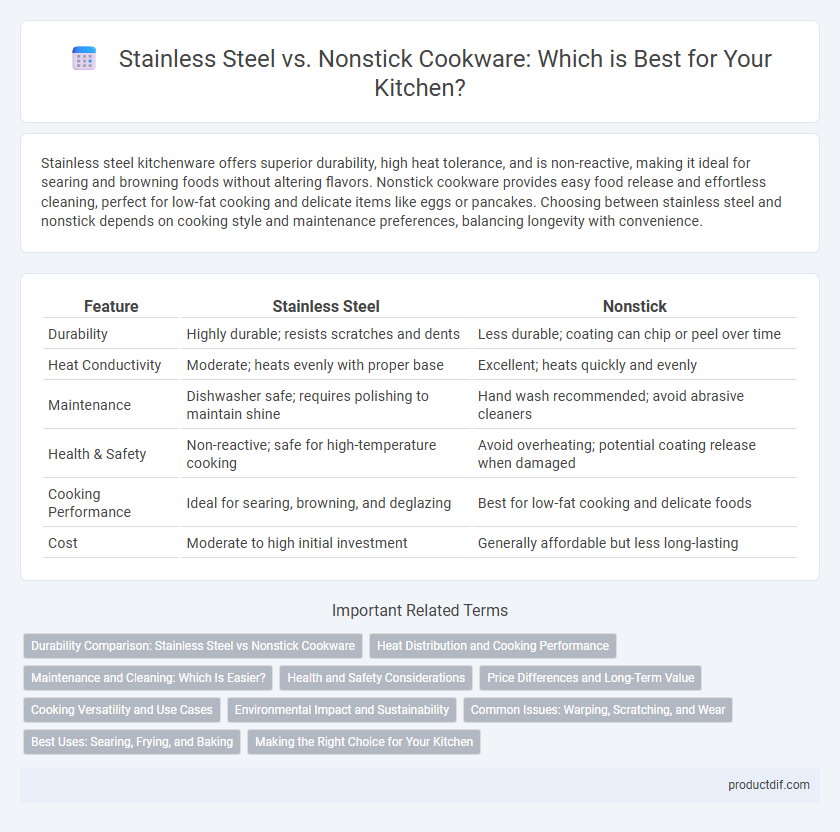Stainless steel kitchenware offers superior durability, high heat tolerance, and is non-reactive, making it ideal for searing and browning foods without altering flavors. Nonstick cookware provides easy food release and effortless cleaning, perfect for low-fat cooking and delicate items like eggs or pancakes. Choosing between stainless steel and nonstick depends on cooking style and maintenance preferences, balancing longevity with convenience.
Table of Comparison
| Feature | Stainless Steel | Nonstick |
|---|---|---|
| Durability | Highly durable; resists scratches and dents | Less durable; coating can chip or peel over time |
| Heat Conductivity | Moderate; heats evenly with proper base | Excellent; heats quickly and evenly |
| Maintenance | Dishwasher safe; requires polishing to maintain shine | Hand wash recommended; avoid abrasive cleaners |
| Health & Safety | Non-reactive; safe for high-temperature cooking | Avoid overheating; potential coating release when damaged |
| Cooking Performance | Ideal for searing, browning, and deglazing | Best for low-fat cooking and delicate foods |
| Cost | Moderate to high initial investment | Generally affordable but less long-lasting |
Durability Comparison: Stainless Steel vs Nonstick Cookware
Stainless steel cookware offers superior durability due to its resistance to warping, scratching, and high heat, lasting for decades with proper care. Nonstick cookware, while convenient for easy food release and cleaning, tends to degrade faster, with coatings typically wearing off after 2 to 5 years. Investing in stainless steel ensures long-term performance and resilience, especially under frequent high-temperature cooking scenarios.
Heat Distribution and Cooking Performance
Stainless steel cookware offers superior heat distribution due to its ability to conduct and retain heat evenly, resulting in consistent cooking performance and better browning. Nonstick pans excel in preventing food from sticking, making them ideal for delicate dishes, but often have less efficient heat conduction, causing uneven cooking. Choosing between stainless steel and nonstick depends on the need for precise heat control versus ease of food release during cooking.
Maintenance and Cleaning: Which Is Easier?
Stainless steel cookware offers superior durability and can withstand aggressive scrubbing without damage, making it easier to maintain long-term despite potential staining. Nonstick pans require gentle cleaning with non-abrasive sponges to preserve their coating, making daily cleaning simpler but more delicate. Overall, stainless steel demands more effort to remove stuck-on food but supports harsher cleaning methods, while nonstick prioritizes effortless cleanup but requires more careful maintenance to prevent coating degradation.
Health and Safety Considerations
Stainless steel cookware is highly resistant to corrosion and does not release harmful chemicals when heated, making it a safer choice for health-conscious users. Nonstick pans, often coated with PTFE or ceramic, can pose health risks if overheated, as toxic fumes or flaking particles may be released. Choosing stainless steel reduces potential exposure to synthetic coatings, ensuring safer cooking environments and food integrity.
Price Differences and Long-Term Value
Stainless steel cookware generally has a higher upfront cost compared to nonstick options but offers superior durability and longevity, making it a cost-effective investment over time. Nonstick pans are cheaper initially but often require more frequent replacement due to coating wear, which can increase long-term expenses. Choosing stainless steel provides better heat retention and resistance to scratches, enhancing value despite the higher initial price.
Cooking Versatility and Use Cases
Stainless steel cookware excels in high-heat cooking, searing, and deglazing, making it ideal for browning meats and creating sauces. Nonstick pans offer superior performance for low-fat cooking and delicate foods like eggs and pancakes due to their easy food release and minimal oil requirement. Choosing between stainless steel and nonstick depends on cooking techniques, with stainless steel favored for versatility and durability, while nonstick is preferred for convenience and gentle food preparation.
Environmental Impact and Sustainability
Stainless steel cookware offers superior environmental sustainability due to its durability, recyclability, and long lifespan, reducing the frequency of replacement and waste generation. Nonstick pans often contain synthetic coatings like PTFE or PFOA, which pose environmental and health concerns during production and disposal, and their shorter lifespan increases landfill waste. Choosing stainless steel minimizes ecological impact by supporting recyclable materials and reducing chemical exposure in manufacturing and disposal processes.
Common Issues: Warping, Scratching, and Wear
Stainless steel cookware often resists warping and scratching due to its rigid construction but can develop surface discoloration and pitting with prolonged use. Nonstick pans are prone to scratching and wear, which deteriorates their coating and reduces nonstick performance, often leading to the release of harmful chemicals at high temperatures. Choosing high-quality materials and proper maintenance can mitigate these common issues, extending the lifespan of both stainless steel and nonstick kitchenware.
Best Uses: Searing, Frying, and Baking
Stainless steel cookware excels at high-heat searing and frying due to its superior heat retention and ability to develop a flavorful crust on meats, making it ideal for techniques requiring browning. Nonstick pans are best suited for low to medium heat frying and delicate tasks like cooking eggs or pancakes, as their coating prevents food from sticking and allows for easy cleanup. When it comes to baking, stainless steel is preferred for oven-safe dishes requiring even heat distribution, while nonstick bakeware is advantageous for releasing baked goods effortlessly without excessive greasing.
Making the Right Choice for Your Kitchen
Stainless steel cookware offers exceptional durability, resistance to high temperatures, and the ability to develop complex flavors through browning, making it ideal for professional chefs and everyday cooks seeking versatility. Nonstick pans excel in easy food release and minimal oil usage, perfect for low-fat cooking and quick cleaning, but they require careful handling to avoid scratching and are less suitable for high-heat searing. Selecting the right kitchenware depends on cooking style, maintenance preferences, and recipe requirements, with stainless steel favored for heavy-duty use and nonstick chosen for convenience and healthy cooking.
Stainless Steel vs Nonstick Infographic

 productdif.com
productdif.com